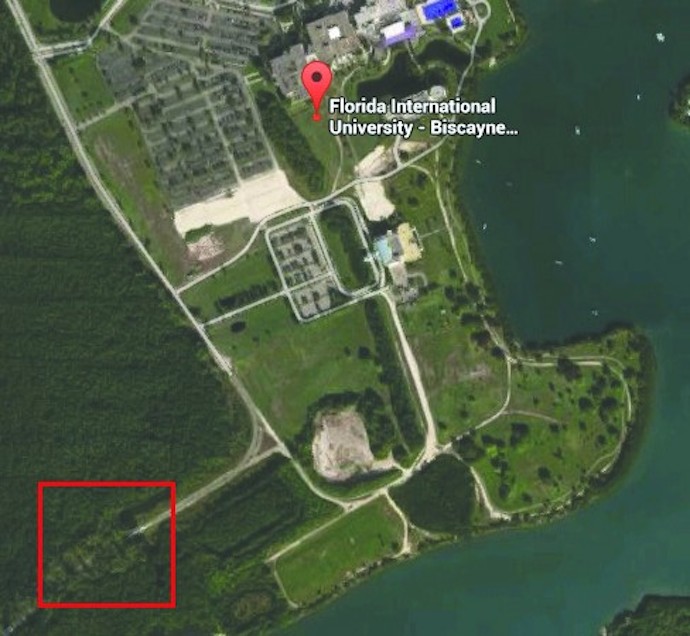While students who need to get to and leave the Biscayne Bay Campus wonder if they or the shuttles will ever be able to travel there on Northeast 135th Street, and as the game of politics is played throughout Miami-Dade County, one man decided to help answer an age old dilemma of the human race when it comes to road making: how do we get across?
That man is Dr. Claudius Carnegie.
He suggested a culvert, a large wrinkled-looking steel pipe, to span a gap that that will connect Northeast 135th where it is closed south of BBC to Northeast 151st.
Rather than a bridge, Carnegie said in a recent interview on WRGP, FIU’s student-run radio station that a culvert is viable, durable and only 30 percent of whatever it would cost to build a bridge.
And there’s another reason.
“The other thing is bridges can be washed out,” Carnegie said. “A culvert can never be washed out.”
But before he can put on his hard-hat on, others must suit up to resolve the politics that usually come before and after construction.
Around the time University President Mark Rosenberg began his presidency at the University, administrators decided it was time to revisit the idea of another access road for BBC, which Rosenberg described as a “major challenge” for FIU as it attempts to expand BBC.
“We’ve already received complaints from our students, our faculty and our professional staff that you can’t get out of that campus,” Rosenberg in a May interview with Student Media.
He suggested it would be irresponsible of the University to expand BBC without also addressing the issue of a second access road.
Rosenberg also said it would be a misuse of University money to add or move programs that exist at MMC to BBC, or vice versa.
“We don’t have the facilities, we don’t have the wetlabs, we don’t have the space,” Rosenberg said.
He added that the University expects BBC’s enrollment to double by 2020 – from 7,500 to 15,000 – because of the Chapman School of Hospitality & Tourism Management, the School of Environment Arts & Society and the School of Journalism & Mass Communication, three programs at BBC Rosenberg are “thriving.”
But before any expansion can take place, the University must face a roadblock that is comprised of many blocks – each with bases of operation scattered across the county.
There are wildlife and environmental protection agencies for each level of government with jurisdiction over a park or preserve in the area. Or, as is the case with the U.S. Environmental Protection Agency, entire acres of land.
BBC sits on the northeast end of a 170-acre former municipal landfill that operated from 1974 to 1981. In cleanup efforts conducted in the 1980s and 90s the EPA has deemed the area safe for people and aquatic wildlife, and determined no further action was needed to address groundwater at the site.
The federal agency removed the former landfill from the national priorities list in 1999 but North Miami, as the responsible party, continues to monitor and provide oversight.
The county’s Environmental Resources Management Department also helps watch over the possible environmental impacts on people and wildlife of any kind of development in the area. And the state’s Department of Environmental Protection and the the U.S. Fish & Wildlife Conservation Commission both help protect Oleta River State Park.
The other players in the political game have their headquarters at the Modesto Maidique Campus, in North Miami City Hall, and the School Administration Building where the county’s school board meets.
The Miami-Dade County Public Schools oversees the Alonzo & Tracy Mourning Sr. High Biscayne Bay Campus and the David Lawrence Jr. K-8 Center, on the left and right sides, respectively, when taking the only road into BBC, Northeast 151st Street.
Once the players involved designate an institutional leader among them, all that’s left is for Carnegie is to do what he’s done for all of his professional career: design and build.
Carnegie also builds the minds of future engineers as an educator; he has taught young people from middle school up through college throughout his career.
As a NASA professor, Carnegie teaches kids in the space agency’s Aeronautics Learning Laboratory for Science Technology and Research out of the University’s Engineering Center on West Flagler Street and SW 107 Avenue.
But as an adjunct professor in the University professor he builds the minds of future engineers in the Department of Mechanical Engineering which is under the College of Computing & Engineering.
Although CEC is at MMC, Carnegie’s work launches from BBC; there he is much closer to and more capable of putting to use at a moment’s notice his experience as a licensed professional engineer.
In the radio interview on WRGP, Carnegie noted that he could be the only engineer at BBC.
“I might be the lone engineer at BBC,” Carnegie said. “Either spelling could work: lone or loan,” he said with a laugh.
His career began in 1971 and since then Carnegie has done professional work earning designations along the way that are as varied as his academic achievements.
He has a bachelor’s degree civil engineering from Loughborough University of Technology in the UK, a master’s degree in civil, structural and transportation engineering from Carleton University in Ottawa, Ontario in Canada, a doctorate in environmental science from Kennedy-Western University in California and a KIND OF doctorate degree in higher educational leadership from Nova Southeastern University.
Carnegie was involved in design and construction related activities in the fields of professional civil, structural and transportation engineering accomplishments in the United Kingdom, parts of the Caribbean, Canada, other states in the U.S., and for the past 18 years he has worked for FIU.
It was his engineering background and a desire to help that compelled Carnegie to contact University administrators.
So with the culvert idea on Carnegie’s drawing board, he said a possible step forward for the project is to get the other players involved to hear what he has to say.







Be the first to comment on "A NASA ALLSTAR has an idea that could ‘bridge’ the gap to the Biscayne Bay Campus"